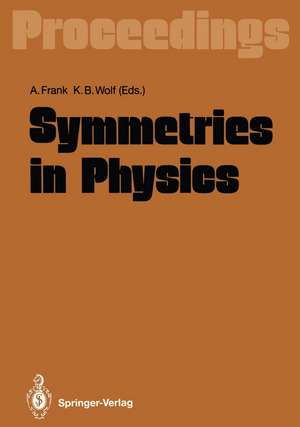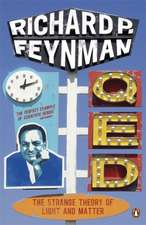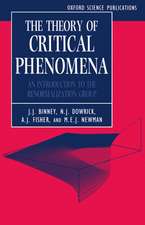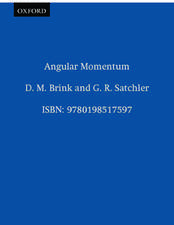Symmetries in Physics: Proceedings of the International Symposium Held in Honor of Professor Marcos Moshinsky at Cocoyoc, Morelos, México, June 3–7, 1991
Editat de Alejandro Frank, Kurt B. Wolfen Limba Engleză Paperback – 20 dec 2011
Preț: 649.39 lei
Preț vechi: 763.99 lei
-15% Nou
Puncte Express: 974
Preț estimativ în valută:
124.26€ • 130.09$ • 102.82£
124.26€ • 130.09$ • 102.82£
Carte tipărită la comandă
Livrare economică 05-19 aprilie
Preluare comenzi: 021 569.72.76
Specificații
ISBN-13: 9783642772863
ISBN-10: 3642772862
Pagini: 420
Ilustrații: XXIV, 390 p.
Dimensiuni: 170 x 242 x 22 mm
Greutate: 0.67 kg
Ediția:Softcover reprint of the original 1st ed. 1992
Editura: Springer Berlin, Heidelberg
Colecția Springer
Locul publicării:Berlin, Heidelberg, Germany
ISBN-10: 3642772862
Pagini: 420
Ilustrații: XXIV, 390 p.
Dimensiuni: 170 x 242 x 22 mm
Greutate: 0.67 kg
Ediția:Softcover reprint of the original 1st ed. 1992
Editura: Springer Berlin, Heidelberg
Colecția Springer
Locul publicării:Berlin, Heidelberg, Germany
Public țintă
ResearchCuprins
1 Group Theory and the Harmonic Oscillator: The Work of Marcos Moshinsky.- 1.1 Introduction.- 1.2 Schematic theory of nuclear reactions.- 1.3 The Moshinsky brackets.- 1.4 Marcos’ harmonic oscillator.- 1.5 Group theory and nuclear structure.- 1.6 Classical canonical transformations and their unitary representation.- 1.7 Rendering accidental degenerancy non-accidental.- 1.8 Collective models.- 1.9 Structure of matter in strong magnetic fields.- 1.10 Relativistic oscillators.- Electronic and Molecular Physics.- 2 Generalizing the BCS Universal Constants to High-Temperature Superconductivity.- 2.1 Introduction.- 2.2 Generalized BCS Tc-formula.- 2.3 Conclusion.- 3 Fermion Clustering in an Exactly- Soluble N-Fermion Model for Hadronic, Nuclear, and Superconductivity Physics.- 3.1 Introduction.- 3.2 Cooper pairing.- 3.3 Conclusions.- 4 The Scattering Approach to Quantum Electronic Transport.- 4.1 Introduction.- 4.2 Two-terminal systems.- 4.3 Beyond the isotropic model.- 4.4 A three-terminal system.- 5 Symmetry-Avoided Crossings and their Role in the Catalytic Activity of Transition Metals.- 5.1 A personal introduction.- 5.2 General introduction.- 5.3 Method.- 5.4 Results.- 5.5 Conclusions.- Nuclear Physics.- 6 The Symplectic Model and Potential-Energy Surfaces.- 6.1 Introduction.- 6.2 The pseudo-symplectic model.- 6.3 A procedure to construct a PES.- 6.4 Application to 1224Mg and 92238U.- 6.5 Conclusions.- 7 The SU(3) Generalization of Racah’s SU(2j + 1) ? SU (2) Group-Subgroup Embedding.- 7.1 Introduction.- 7.2 Resumé of Racah’s method.- 7.3 The U(3) ? U(dim[m]) embedding.- 7.4 Racah basis for the Lie algebra of any subgroup G ? U(dim[m]).- 7.5 Zeroes of U(3) Racah coefficients.- 8 Scaling and Universality in the Shock Compression of Condensed Matter.- 8.1 Introduction.- 8.2 Rankine-Hugoniot equations.- 8.3 Universality.- 8.4 The empirical expressions for the pressure and internal energy on the shock Hugoniot.- 8.5 A law of corresponding states: scaling.- 8.6 Formal implicit solution for the pressure on the Hugoniot..- 8.7 Conditions on R(P, V) for a double pole in PH(V).- 8.8 Consistency conditions.- 8.9 The complete equation of state in the strong shock regime.- 8.10 The thermodynamic coefficients, the specific heat and the Grüneisen parameter.- 8.11 A thermodynamic expression for the constant A.- 8.12 Summary of results and conclusions.- 9 Deriving Nuclei from Quarks.- 9.1 Introduction.- 9.2 Boson expansions.- 9.3 Iterative mappings of quark systems.- 9.4 The Bonn quark shell model.- 9.5 Results of test calculations for 16O.- 9.6 Concluding remarks.- 10 Binding Energies of Nuclei and Atoms.- Particles and Relativity.- 11 The Relativistic Oscillator and Mass Formulas.- 12 Relativistic Equations in External Fields.- 12.1 Introduction.- 12.2 The Dirac oscillator, a study case.- 12.3 Extended supersymmetric Hamiltonians.- 12.4 Dirac equation in 3 + 1 dimensions.- 12.5 Susy Dirac equation in 4 + 1 and 2 + 1 dimensions.- 12.6 Beyond supersymmetry.- 12.7 Conclusions.- 13 A Parallelism Between Quantum Gravity and the IR Limit in QCD (Emergence of Hadron and Nuclear Symmetries).- 13.1 Symmetries in Nuclei: the IBM Quadrupolar Algebraics.- 13.2 Gravity-like features in hadron dynamics.- 13.3 Flavor SU(3) is generated by QCD, once the fifth is set aside.- 13.4 “Effective” strong gravity is induced by QCD.- 13.5 The algebraics of hadrons and nuclei (classical and quantum).- 13.6 Hadron systematics.- 13.7 The interacting boson model in nuclei.- 13.8 Quadrupolar symmetries in nuclei.- 14 On Rainich-Misner-Wheeler Conditions in Nonlinear Electrodynamics.- 15 Hamiltonian Formulation of a Simple Covariant Harmonic Oscillator for Bosons and Fermions.- 15.1 Introduction.- 15.2 Light cone Hamiltonian formalism.- 15.3 Covariant harmonic oscillator model for two spin-0 constituents.- 15.4 Covariant harmonic oscillator models for two spin-1/2 constituents.- 15.5 Summary and conclusions.- 15.6 Appendix A.- Symmetry and Decay.- 16 Doorway States in Classical Physics.- 16.1 Introduction.- 16.2 The acoustical model.- 16.3 The mathematical setting.- 16.4 Numerical results.- 16.5 Conclusions.- 17 Resonant States and the Decay Process.- 17.1 Introduction.- 17.2 The nondecay amplitude.- 17.3 Time-dependent Green function and resonant states.- 17.4 Full discrete expansion of g(r,r?;t) and A(t).- 17.5 Example.- 17.6 Exact one-level decay formula.- 17.7 Conclusion.- 17.A Appendix: Determination of the residue at the pole of the outgoing Green function.- 18 The Decay Process: An Exactly Soluble Example and its Implications.- 18.1 Introduction.- 18.2 A paradox.- 18.3 The problem.- 18.4 The solution.- 18.5 The behavior of A(K,t) for large times.- 18.6 The behavior of A(K,t) for very short times.- 18.7 Conclusion.- 18.A Appendix.- 19 Moshinsky Functions, Resonances and Tunneling.- 19.1 Introduction.- 19.2 The Moshinsky function.- 19.3 Applications: transient effects.- 19.4 Applications: one-dimensional tunneling.- 19.5 Applications: decay.- 19.6 Applications: resonance scattering.- Phase Space Dynamics.- 20 Nonstationary Oscillator in Quantum Mechanics.- 20.1 Introduction.- 20.2 Linear integrals of motion.- 20.3 “Ground” state and coherent states of the parametric oscillator.- 20.4 Fock states and transition probabilities of the time-dependent oscillator.- 20.5 Invariants and propagator.- 20.6 “Damped” oscillator.- 20.7 Casimir effect and parametric oscillator.- 21 Symmetry and Dynamical Lie Algebras in Classical and Quantum Mechanics.- 21.1 Introduction.- 21.2 Definition and properties of symmetry and dynamical Lie algebras.- 21.3 The case of two-dimensional rotationally-invariant Hamiltonians in classical mechanics.- 21.4 The case of two-dimensional rotationally-invariant Hamiltonians in quantum mechanics.- 21.5 Conclusion.- 22 Canonical Transformations in Mechanics vis-à-vis Those in Optics.- 22.1 Introduction.- 22.2 The phase space of mechanics and that of optics.- 22.3 Transformations in mechanical vis-à-vis optical phase space.- 22.4 The canonical transformations that are specific to optics...- 22.5 Outlook: canonical transformations in wave optics.- Round Table.- 23 Science and Technology in Latin America.- Author index.












